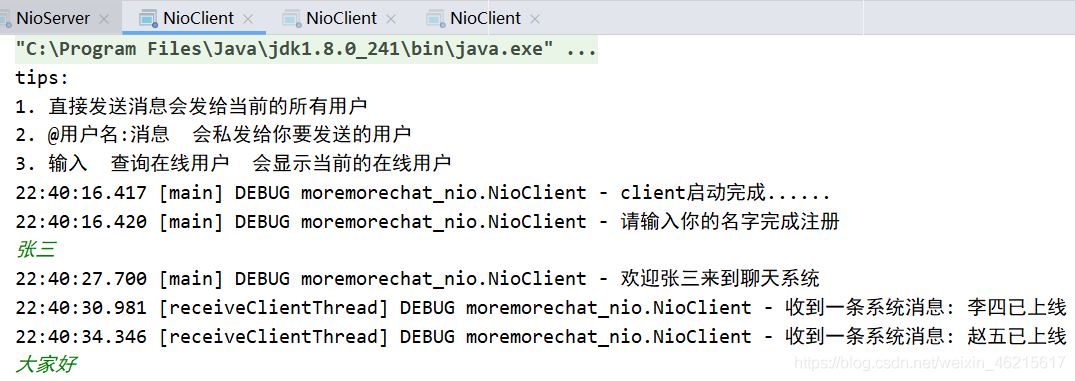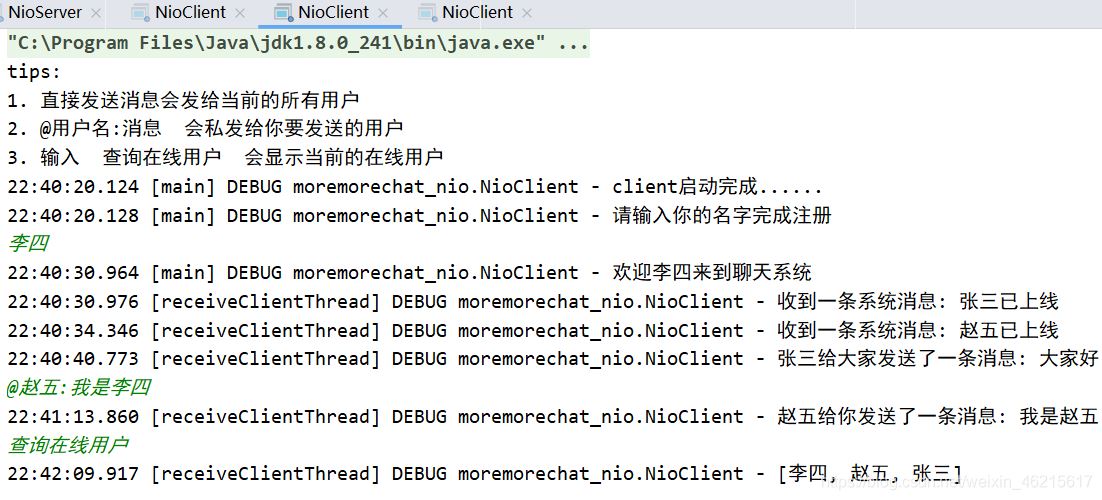Java實現NIO聊天室的示例代碼(群聊+私聊)
功能介紹
功能:群聊+私發+上線提醒+下線提醒+查詢在線用戶




文件
Utils
需要用maven導入下面兩個包
<dependency>
<groupId>org.projectlombok</groupId>
<artifactId>lombok</artifactId>
<version>1.16.18</version>
</dependency>
<dependency>
<groupId>ch.qos.logback</groupId>
<artifactId>logback-classic</artifactId>
<version>1.2.3</version>
</dependency>
package moremorechat_nio;
import lombok.extern.slf4j.Slf4j;
import java.io.*;
/**
* @author mazouri
* @create 2021-05-09 22:26
*/
@Slf4j
public class Utils {
/**
* 將二進制數據轉為對象
*
* @param buf
* @return
* @throws IOException
* @throws ClassNotFoundException
*/
public static Message decode(byte[] buf) throws IOException, ClassNotFoundException {
ByteArrayInputStream bais = new ByteArrayInputStream(buf);
ObjectInputStream ois = new ObjectInputStream(bais);
return (Message) ois.readObject();
}
/**
* 將對象轉為二進制數據
*
* @param message
* @return
*/
public static byte[] encode(Message message) throws IOException {
ByteArrayOutputStream baos = new ByteArrayOutputStream();
ObjectOutputStream oos = new ObjectOutputStream(baos);
oos.writeObject(message);
oos.flush();
return baos.toByteArray();
}
}
FinalValue
package moremorechat_nio;
/**
* @author mazouri
* @create 2021-05-05 21:00
*/
public final class FinalValue {
/**
* 系統消息
*/
public static final int MSG_SYSTEM = 0;
/**
* 群發消息
*/
public static final int MSG_GROUP = 1;
/**
* 私發消息
*/
public static final int MSG_PRIVATE = 2;
/**
* 客戶端請求在線人員
*/
public static final int MSG_ONLINE = 3;
/**
* 客戶端將用戶名稱發送給服務端
*/
public static final int MSG_NAME = 4;
}
Message
package moremorechat_nio;
import java.io.Serializable;
/**
* @author mazouri
* @create 2021-05-05 21:00
*/
public class Message implements Serializable {
public int type;
public String message;
public Message() {
}
public Message(String message) {
this.message = message;
}
public Message(int type, String message) {
this.type = type;
this.message = message;
}
@Override
public String toString() {
return "Message{" +
"type=" + type +
", message='" + message + '\'' +
'}';
}
}
NioServer
package moremorechat_nio;
import lombok.extern.slf4j.Slf4j;
import java.io.*;
import java.net.InetSocketAddress;
import java.nio.ByteBuffer;
import java.nio.channels.*;
import java.util.ArrayList;
import java.util.Iterator;
import java.util.Set;
import java.util.concurrent.atomic.AtomicBoolean;
import java.util.stream.Collectors;
import static moremorechat_nio.FinalValue.*;
/**
* ctrl+f12 方法
* ctrl+alt+左鍵
* @author mazouri
* @create 2021-05-09 19:24
*/
@Slf4j
public class NioServer {
private Selector selector;
private ServerSocketChannel ssc;
public NioServer() {
try {
// 創建 selector, 管理多個 channel
selector = Selector.open();
//打開ServerSocketChannel,用於監聽客戶端的連接,它是所有客戶端連接的父通道
ssc = ServerSocketChannel.open();
ssc.bind(new InetSocketAddress(8888));
//設置連接為非堵塞模式
ssc.configureBlocking(false);
// 2. 建立 selector 和 channel 的聯系(註冊)
// SelectionKey 就是將來事件發生後,通過它可以知道事件和哪個channel的事件
//將ServerSocketChannel註冊到Reactor線程的多路復用器Selector上,監聽ACCEPT事件
ssc.register(selector, SelectionKey.OP_ACCEPT);
} catch (IOException e) {
e.printStackTrace();
}
}
public static void main(String[] args) {
NioServer server = new NioServer();
log.debug("server啟動完成,等待用戶連接...");
try {
server.listen();
} catch (Exception e) {
log.debug("發生瞭一些問題");
}
}
/**
* 監聽用戶的連接
*
* @throws Exception
*/
private void listen() throws Exception {
while (true) {
// select 方法, 沒有事件發生,線程阻塞,有事件,線程才會恢復運行, 通過Selector的select()方法可以選擇已經準備就緒的通道 (這些通道包含你感興趣的的事件)
//通過Selector的select()方法可以選擇已經準備就緒的通道 (這些通道包含你感興趣的的事件)
// select 在事件未處理時,它不會阻塞, 事件發生後要麼處理,要麼取消,不能置之不理
selector.select();
// 處理事件, selectedKeys 內部包含瞭所有發生的事件
Iterator<SelectionKey> iterator = selector.selectedKeys().iterator();
while (iterator.hasNext()) {
SelectionKey key = iterator.next();
// 處理key 時,要從 selectedKeys 集合中刪除,否則下次處理就會有問題
iterator.remove();
// 區分事件類型
if (key.isAcceptable()) {
ServerSocketChannel channel = (ServerSocketChannel) key.channel();
SocketChannel sc = channel.accept();
sc.configureBlocking(false);
sc.register(selector, SelectionKey.OP_READ);
} else if (key.isReadable()) {
dealReadEvent(key);
}
}
}
}
/**
* 處理讀事件
*
* @param key
*/
private void dealReadEvent(SelectionKey key) {
SocketChannel channel = null;
try {
channel = (SocketChannel) key.channel();
ByteBuffer buffer = ByteBuffer.allocate(1024);
int read = channel.read(buffer);
// 如果是正常斷開,read 的方法的返回值是 -1
if (read == -1) {
//cancel 會取消註冊在 selector 上的 channel,並從 keys 集合中刪除 key 後續不會再監聽事件
key.cancel();
} else {
buffer.flip();
Message msg = Utils.decode(buffer.array());
log.debug(msg.toString());
dealMessage(msg, key, channel);
}
} catch (IOException | ClassNotFoundException e) {
System.out.println((key.attachment() == null ? "匿名用戶" : key.attachment()) + " 離線瞭..");
dealMessage(new Message(MSG_SYSTEM, key.attachment() + " 離線瞭.."), key, channel);
//取消註冊
key.cancel();
//關閉通道
try {
channel.close();
} catch (IOException ioException) {
ioException.printStackTrace();
}
}
}
/**
* 處理各種消息,並發送給客戶端
*
* @param msg
* @param key
* @param channel
*/
private void dealMessage(Message msg, SelectionKey key, SocketChannel channel) {
switch (msg.type) {
case MSG_NAME:
key.attach(msg.message);
log.debug("用戶{}已上線", msg.message);
getConnectedChannel(channel).forEach(selectionKey -> {
SocketChannel sc = (SocketChannel) selectionKey.channel();
sendMsgToClient(new Message("收到一條系統消息: " + msg.message + "已上線"), sc);
});
break;
case MSG_GROUP:
getConnectedChannel(channel).forEach(selectionKey -> {
SocketChannel sc = (SocketChannel) selectionKey.channel();
sendMsgToClient(new Message(key.attachment() + "給大傢發送瞭一條消息: " + msg.message), sc);
});
break;
case MSG_PRIVATE:
String[] s = msg.message.split("_");
AtomicBoolean flag = new AtomicBoolean(false);
getConnectedChannel(channel).stream().filter(sk -> s[0].equals(sk.attachment())).forEach(selectionKey -> {
SocketChannel sc = (SocketChannel) selectionKey.channel();
sendMsgToClient(new Message(key.attachment() + "給你發送瞭一條消息: " + s[1]), sc);
flag.set(true);
});
if (!flag.get()){
sendMsgToClient(new Message(s[1]+"用戶不存在,請重新輸入!!!"), channel);
}
break;
case MSG_ONLINE:
ArrayList<String> onlineList = new ArrayList<>();
onlineList.add((String) key.attachment());
getConnectedChannel(channel).forEach(selectionKey -> onlineList.add((String) selectionKey.attachment()));
sendMsgToClient(new Message(onlineList.toString()), channel);
break;
case MSG_SYSTEM:
getConnectedChannel(channel).forEach(selectionKey -> {
SocketChannel sc = (SocketChannel) selectionKey.channel();
sendMsgToClient(new Message("收到一條系統消息: " + msg.message), sc);
});
break;
default:
break;
}
}
/**
* 發送消息給客戶端
*
* @param msg
* @param sc
*/
private void sendMsgToClient(Message msg, SocketChannel sc) {
try {
byte[] bytes = Utils.encode(msg);
sc.write(ByteBuffer.wrap(bytes));
} catch (IOException e) {
log.debug("sendMsgToClient出現瞭一些問題");
}
}
/**
* 獲取所有channel,除去調用者
*
* @param channel
* @return
*/
private Set<SelectionKey> getConnectedChannel(SocketChannel channel) {
return selector.keys().stream()
.filter(item -> item.channel() instanceof SocketChannel && item.channel().isOpen() && item.channel() != channel)
.collect(Collectors.toSet());
}
}
NioClient
package moremorechat_nio;
import lombok.extern.slf4j.Slf4j;
import java.io.*;
import java.net.InetSocketAddress;
import java.nio.ByteBuffer;
import java.nio.channels.SelectionKey;
import java.nio.channels.Selector;
import java.nio.channels.SocketChannel;
import java.util.Iterator;
import java.util.Scanner;
import static moremorechat_nio.FinalValue.*;
/**
* @author mazouri
* @create 2021-04-29 12:02
*/
@Slf4j
public class NioClient {
private Selector selector;
private SocketChannel socketChannel;
private String username;
private static Scanner input;
public NioClient() throws IOException {
selector = Selector.open();
socketChannel = SocketChannel.open(new InetSocketAddress("127.0.0.1", 8888));
socketChannel.configureBlocking(false);
socketChannel.register(selector, SelectionKey.OP_READ);
log.debug("client啟動完成......");
log.debug("請輸入你的名字完成註冊");
input = new Scanner(System.in);
username = input.next();
log.debug("歡迎{}來到聊天系統", username);
}
public static void main(String[] args) throws IOException {
System.out.println("tips: \n1. 直接發送消息會發給當前的所有用戶 \n2. @用戶名:消息 會私發給你要發送的用戶 \n3. 輸入 查詢在線用戶 會顯示當前的在線用戶");
NioClient client = new NioClient();
//啟動一個子線程接受服務器發送過來的消息
new Thread(() -> {
try {
client.acceptMessageFromServer();
} catch (Exception e) {
e.printStackTrace();
}
}, "receiveClientThread").start();
//調用sendMessageToServer,發送消息到服務端
client.sendMessageToServer();
}
/**
* 將消息發送到服務端
*
* @throws IOException
*/
private void sendMessageToServer() throws IOException {
//先把用戶名發給客戶端
Message message = new Message(MSG_NAME, username);
byte[] bytes = Utils.encode(message);
socketChannel.write(ByteBuffer.wrap(bytes));
while (input.hasNextLine()) {
String msgStr = input.next();
Message msg;
boolean isPrivate = msgStr.startsWith("@");
if (isPrivate) {
int idx = msgStr.indexOf(":");
String targetName = msgStr.substring(1, idx);
msgStr = msgStr.substring(idx + 1);
msg = new Message(MSG_PRIVATE, targetName + "_" + msgStr);
} else if ("查詢在線用戶".equals(msgStr)) {
msg = new Message(MSG_ONLINE, "請求在線人數");
} else {
msg = new Message(MSG_GROUP, msgStr);
}
byte[] bytes1 = Utils.encode(msg);
socketChannel.write(ByteBuffer.wrap(bytes1));
}
}
/**
* 接受從服務器發送過來的消息
*/
private void acceptMessageFromServer() throws Exception {
while (selector.select() > 0) {
Iterator<SelectionKey> iterator = selector.selectedKeys().iterator();
while (iterator.hasNext()) {
SelectionKey key = iterator.next();
iterator.remove();
if (key.isReadable()) {
SocketChannel sc = (SocketChannel) key.channel();
ByteBuffer buffer = ByteBuffer.allocate(1024);
sc.read(buffer);
Message message = Utils.decode(buffer.array());
log.debug(String.valueOf(message.message));
}
}
}
}
}
到此這篇關於Java實現NIO聊天室的示例代碼(群聊+私聊)的文章就介紹到這瞭,更多相關Java NIO聊天室內容請搜索WalkonNet以前的文章或繼續瀏覽下面的相關文章希望大傢以後多多支持WalkonNet!